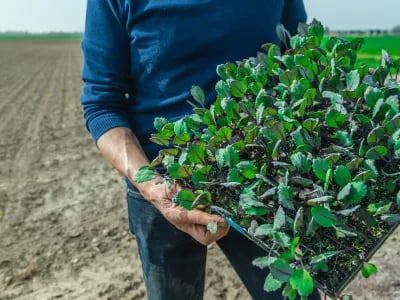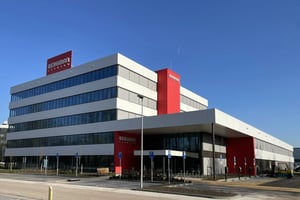The Netherlands must become a global leader in circular agriculture by 2030 – that’s the goal set last year by Carola Schouten, Minister of Agriculture, Nature and Food Quality in the Netherlands. In her policy plan ‘Op weg met perspectief’ (‘On the way to future prospects’; link in Dutch), she recently took her first tentative steps towards this form of agriculture, which prioritises a sustainable relationship with natural resources such as soil, air and water over simply producing as much food as possible, as cheaply as possible. But what actually is circular agriculture? And what implications does it have for technology and cultivation techniques?
With a quote of Adri den Dekker, Manager for Agriculture, Purchasing and Sustainability at HAK, an NPM Capital portfolio company.
For more than half a century, both within the Netherlands and in Europe more broadly, agricultural policy focused on producing as much food as possible, efficiently and at low prices, whilst providing an acceptable level of income for the farmer. One effect of this focus was that the Netherlands’ agricultural sector grew until it made the country the second most productive nation in the world in terms of agricultural exports. Now, however, the downsides of this intensive agricultural system are becoming increasingly apparent. Arable farming, with its large-scale production and excessive use of artificial fertiliser and chemical pesticides, is heading for a dead end: the soil is nearing exhaustion, the quality of the landscape is deteriorating, biodiversity is declining dramatically and the planet’s temperature is rising (agriculture is one of the biggest catalysts for the greenhouse effect). Cattle farming is in a similar situation: animal welfare has been under pressure for decades now, and – in addition to the large amounts of manure produced by the animals – enormous quantities of soy are imported for cattle feed.
This system needs to change. That message is no longer coming just from environmental activists, but now also from distinguished scientists and organisations both within the Netherlands and abroad, such as the Council for the Environment and Infrastructure, the Netherlands Environmental Assessment Agency and the National Institute for Public Health and the Environment. Efficient production is still necessary – not least because the demand for food and other agricultural products and resources is only set to increase – but we need to expand our definition of what efficient production means. Efficiency has to mean not just economic performance but also environmental efficiency, being smarter in the way we use natural processes and reducing the amounts of natural resources we use; ideally, doing this in such a way as to create an attractive landscape and new earnings models for our farmers.
Circular agriculture
The key concept in this broader definition of efficiency is circular agriculture. Under this system, as much as possible of the agricultural biomass and the nutrients it contains are retained in the food system. In other words, the amount of nutrients leaking out of the system is kept to a minimum, thereby reducing the need to add nutrients from elsewhere, such as through artificial fertiliser or imported cattle feed. In practice, this means that farming, both arable and pastoral, needs to develop a much more symbiotic relationship with production than is currently the case.
In a circular agricultural system, fields are mainly used to produce food crops or maize feed (an alternative to importing soy from other countries). Grassland – and hence also cattle farming – is most predominant in areas where arable farming is difficult or even impossible. Fields are used most efficiently by sowing crops consecutively, so that the land is in use for most of the year. Dual-purpose crops have a key role to play: the residues left after they are harvested, such as leaves and stalks, can be fed to animals or used to improve the soil. Artificial fertiliser is used sparingly, and only when the crop needs extra nutrition. For the rest of the time, manure, compost and crop residues are used wherever possible to stimulate soil life.
For cattle farmers, circular agriculture means mainly using roughage sourced from their own farms, as well as from waste flows from arable farming, horticulture and the food industry (such as protein-rich beet leaves) and the rest of the food chain. This also includes waste flows that are not currently being used to their maximum potential, or which cannot legally be used, such as meal cultivated from insects and worms on arable waste and ‘swill’ (boiled food waste), algae and seaweed. In contrast with the way we currently work, this system minimises the amount of proteins that get diverted into animal feed even though they are suitable for human consumption (including soy). It also produces high-quality fertiliser by separating faeces and urine at the source: in the stall or slurry pit.
A giant step in the right direction
Circular agriculture keeps the cycles as closed as possible, not only because this is more efficient, but also because a loss of nutrients causes air, water and soil pollution and a loss of biodiversity. That said, it will never be possible to close the cycles completely while humans are part of the system: strictly speaking, human faeces and urine should also be returned to the system, something that would involve the total redesign of sewage systems that have been constructed over generations.
In short: even if we achieved 100% recycling, we still wouldn’t be able to entirely prevent the loss of nutrients from the cycle. Still, it is widely believed that the broad application of the principles of circular agriculture would represent a giant step in the right direction, not least because circular agriculture takes a broad approach to the system, an approach that prioritises the health of the crop and the welfare of the animal. That approach begins with robust plants and animals, with using natural selection to produce plants and animals that have a greater resistance both to diseases and pests and to the effects of climate change.
The use of agricultural biodiversity in, on and around the fields can promote resilience in crops as a form of natural pollination and organic crop protection. There are various ways this can be achieved, such as growing flowers in field margins, introducing wildflower strips and creating nesting areas for beneficial insects that offer hiding places for wild bees, other pollinators and pests’ natural enemies. Getting back to the natural processes is not only good for agriculture – it also helps create a more natural landscape.
Finally, circular agriculture offers many more possibilities for reducing greenhouse gas emissions than can be found in regular agriculture, such as avoiding the organic degradation of unused biomass, including plant residues and manure, and reducing the use of artificial fertiliser. All these benefits help achieve a substantial gain for the climate.
A thorough redesign
So we can see that circular agriculture has practically no downsides – practically none, since in order to achieve circularity the current agricultural system is going to have to be thoroughly redesigned. Intensive cattle farming at the level we’re used to will no longer be possible, and that’s going to have an impact on big economic interests.
Circular agriculture will also involve much greater use of strip farming and mixed crops: different crops will be cultivated at the same time, either in adjacent strips or actually on the same plot of land. That will be hard to achieve with our current machinery, since the different crops will have to be sown, fertilised and harvested at different times. However, experts believe that this will become possible as rapid developments in sensors and robotics bring new forms of precision machinery to the market.
Last but not least, there is also the fact that the production capacity of a circular agriculture system is limited by the availability of circular raw materials. Intensive agriculture based on artificial fertiliser will no longer be an option, and neither will intensive cattle farming based on soy. That will have consequences for our current eating habits: we’re going to have to take a new approach to food, with more vegetarian options and (a lot) less meat.
All of this shows that what circular agriculture represents is not a one-size-fits-all solution, but rather an ongoing search for potential new directions for food production. This search is interwoven with the development of a broad, bio-based economy that uses biomass to produce materials and chemicals. What’s more, this form of agriculture presents Dutch farmers with a huge challenge, a revolution on the scale of the transition to high-production agriculture in the 1950s and 1960s. In the coming years, everyone involved in the (food) chain will have to commit to overcoming the technological, economic, legislative and social barriers.
Adri den Dekker, Manager for Agriculture, Purchasing and Sustainability at HAK:
“I’d say the question mark at the end of the title of this article should be an exclamation mark: we absolutely have to switch to a more circular form of agriculture. That starts with healthy soil, soil that contains enough organic material and enough living organisms so oxygen gets into the ground. Breeding the different varieties and seed types is important too. A combination of resilient soil and resilient crops means you don’t need to use as much pesticide. Our strategy encompasses both these elements, and they are also essential pillars of ‘On the way to PlanetProof’, the responsible cultivation and production method and certification that HAK will be working hard on in the coming years as part of our new sustainability strategy, ‘De Groene Keuken van HAK’ (‘HAK Green Cuisine’).”
“When our growers harvest their crops, there’s always some harvesting residue left behind on the land. That residue stays there and is used as plant-based fertiliser. A lot of growers also sow extra fertiliser crops, so they don’t need as much artificial fertiliser. That’s a big issue: we have to use more processed animal manure if we want to keep the soil really healthy. The article also talks about the rise of what is known as strip cropping. I think that’s going to be pretty difficult in efficiency terms, because it means you have to go out into the fields at different times with different harvesting machines – and all that heavy machinery compresses and closes off the soil. I do believe in the ‘Veldleeuwerik’ (‘Skylark’) approach, where you plant strips of flowers around the plot or even on the same piece of land. That brings a lot more biodiversity, which means more natural pest control. That’s something else we’ve seen in the ‘On the Way to PlanetProof’ strategy.”
“The article suggests that circular agriculture means we’ll have to change our eating habits too: more vegetable protein and less animal protein. This is fully in line with the strategy at HAK; we are really keen to promote a diet high in pulses, which are rich in plant proteins. We’re doing tests with pulses such as kidney beans and chickpeas, sourced from Dutch growers, in an effort to source as much as possible of that healthy plant-based protein locally. That’s part of circular agriculture too: making the circle as small as possible.”
Also read about the innovative agricultural machinery by Ploeger Oxbo Group: ‘Innovation in the field’













